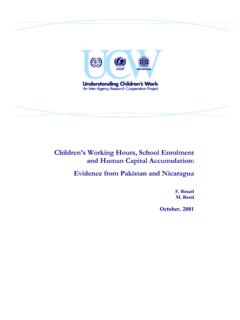Transcription of The effect of availability and distance from school on ...
1 Understanding Children's Work Project Working Paper Series, May 2007. 1. The effect of availability and distance from school on children's time al location in Ghana and Guatemala D. Vuri May 2007. The effect of availability and distance from school on children's time allocation in Ghana and Guatemala D. Vuri*. Working Paper May 2007. Understanding Children's Work (UCW) Project University of Rome Tor Vergata . Faculty of Economics V. Columbia 2. 00133 Rome Tor Vergata Tel: +39 Fax: +39 Email: As part of broader efforts toward durable solutions to child labor, the International Labour Organization (ILO), the United Nations Children's Fund (UNICEF), and the World Bank initiated the interagency Understanding Children's Work (UCW) project in December 2000.
2 The project is guided by the Oslo Agenda for Action, which laid out the priorities for the international community in the fight against child labor. Through a variety of data collection, research, and assessment activities, the UCW project is broadly directed toward improving understanding of child labor, its causes and effects, how it can be measured, and effective policies for addressing it. For further information, see the project website at This paper is part of the research carried out within UCW (Understanding Children's Work), a joint ILO, World Bank and UNICEF project. The views expressed here are those of the authors' and should not be attributed to the ILO, the World Bank, UNICEF or any of these agencies' member countries.
3 *. University of Rome Tor Vergata, CHILD, IZA and CESifo The effect of availability and distance from school on children's time allocation in Ghana and Guatemala Working Paper May 2007. ABSTRACT. In this paper we present evidence on the impact of distance to school and school availability on households' decisions concerning primary age children's time allocation between work, schooling and household chores activities using data from the Ghana Living Standard Survey 1998-99 (GLSS) and the Guatemalan Living Standards Measurement Survey 2000 (ENCOVI). Overall, our results indicate that the increased and eased access to school has a well-defined impact on children's time use with both similarities and striking dissimilarities between the chosen countries.
4 In particular, in Ghana the availability and the travel distance from schools (both primary and middle) in the community influence children's work in both economic activities and household chores and school attendance. The longer the travel time to school the more difficult is for children to reconcile work and school attendance. In Guatemala, secondary school access constraints have almost no effect on children's time allocation. In addition, reducing the cost of access to primary education has an effect only on children's school attendance but it does reduce neither child work nor time spent in household chores. Our results are robust to control for the endogeneity of school placement and per capita expenditures.
5 The effect of availability and distance from school on children's time allocation in Ghana and Guatemala Working Paper May 2007. CONTENTS. 1. Introduction .. 1. 2. Review of the literature .. 3. 3. Theoretical Framework .. 4. 4. Empirical strategy .. 5. 5. Data and variables .. 7. The Ghana Living Standard Survey 1998-99 (GLSS) .. 7. The Guatemalan Living Standards Measurement Survey 2000 .. 10. 6. Child work, schooling and household chores activities: some descriptive evidence .. 12. Ghana .. 12. 19. 7. Regression results .. 27. The working and schooling decisions in Ghana .. 27. The working and schooling decisions in Guatemala .. 32. The working, schooling and household chores decisions in 37.
6 The working, schooling and household chores decisions in Guatemala .. 42. 8. Robustness 45. Ghana .. 45. 49. 9. Conclusion .. 51. References .. 53. Appendix .. 56 1 UCW WORKING PAPER SERIES, MAY 2007. 1. INTRODUCTION. 1. There is almost universal agreement that child labor is undesirable because it negatively affects a child's future welfare in exchange of immediate benefit. The benefits to the household of sending children to work are the income of the child and the reduced schooling expenditures for not sending him/her to school . However, work early in life has a cost for children in terms of lower future earnings when entering the labor market as adults due to the lower educational attainment obtained during childhood.
7 In addition, there are clear spillover effects: more educated children once adults will raise healthier children affected by lower morbidity and lower mortality rates. 2. Despite the acknowledgment that work by children may be harmful for them, child work is a widespread phenomena in the developing word. The International Labor Office (2006) estimates that about 191 million children aged 5-14 years were working in 2004. Of these working children, 74 million were in hazardous work, and 108 million were below the age of 12 years. Moreover, the UNESCO estimates that about one out of five primary school aged children were not enrolled in school . Regionally, the ILO estimates that Asia has the largest number of child workers, but the incidence is highest in Africa (about 1 in 4 children younger than 15 years are economically active in Africa, as compared to 1 in 5 in the Asia-Pacific region, and 1.)
8 In 20 in Latin America and the Caribbean). For these children, the primary cost of child work is the reduction in investment in their human capital and this occurs mainly because child work interferes with schooling, yielding to not-attendance or early drop-out and entry into full-time work. 3. school represents the most important means of drawing children away from the labor market (ILO 1992). Two channels have been mainly used to improve access to education for poor households in developing countries: investments in infrastructure on one side (supply side) and subsidies to investment in education by the poor and school quality improvement on the other (demand side).
9 The relative importance of school supply versus household demand factors has serious implications for education In many developing countries, especially in rural areas, supply constraints, such as difficult access to schools in terms of high distance from the nearest school or high travel cost, might have a non negligible effect on children's time allocation. Furthermore, schooling costs may not be constant throughout the education cycle, and supply constraints on middle and secondary education could be part of the reason why so many children in developing countries do not attend school at all or drop out of the primary school . In addition, not only direct costs (tuition fees and travel time).
10 But also the indirect costs of schooling (the opportunity costs of time spent in school instead of working), can vary in the course of the schooling cycle. In this context, it is important to understand the dynamics of the households' decision making concerning children's activities. If not, public investments in education are not likely to reach the 2. For example, if children enrollment and attendance rates do not depend on local school infrastructure, the construction of new schools will have negligible effect on overall schooling levels and working rates and it would lead to a waste of resources. In this case, policymakers would make it better to direct the marginal efforts on the demand side of the problem.




